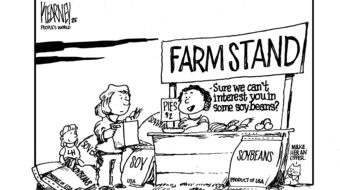
The addition of General Electric CEO Jeffrey Immelt to the third top Obama administration position on economic policy tells an important tale about this political moment, but more importantly, about the struggle within ruling economic and policy elites over the fundamental structural changes that recovery from the great financial crisis requires.
GE was itself clearly a recent un-indicted co-conspirator in the “too big to fail” group of companies whose risky betting adventures in the financial sector with their clients’ money led to disaster which the taxpayers have had to pick up the insurance on.
For years “the most profitable corporation in the world,” GE’s Financial Services division, as well as Goldman Sachs and JPMorgan, were all revealed as the chief beneficiaries of the Federal Reserve and Treasury’s efforts to keep the investments and bonds issued by the failed AIG, Bear Stearns and Lehman Brothers institutions from causing wider damage on Wall Street. As a consequence, GE, JPMorgan Chase, Goldman Sachs and others walked away from the crisis clean, without losing a dime, unlike the rest of the country. Why? They were “too big to fail”..
Now this upfront romance between GE and the liberal side of Wall Street (I call them the “Rubinistas,” referring to Citigroup’s Robert Rubin) seems to have emerged as the strongest player and organizer in the president’s drive to mobilize private capital to support the big structural and educational investments that must be made to both cooperate and compete in a global economy.
But the story with GE in particular is a lot thicker than that. For decades, General Electric was the iconic examplar of corporate America: rich, industrial, innovative, professional, sponsor of the top think tanks, trainer of presidents and CEOs. The list of Fortune 500 CEOs is sprinkled with graduates of GE’s legendary executive training regimen. If you are good enough to survive being a GE VP, you can probably manage most standalone corporations.
No corporation contributed more to the career and elections of Ronald Reagan, whose political career was practically a GE creation going all the way back to the ’50s, when he used to tour GE plants for the company urging workers to reject joining unions, or, if they had to join one, to be sure they joined an anti-communist one. No corporation did more to put in place the post-1975 drive toward unregulated financialization as a means of accumulating the capital resources for capitalism itself to reproduce itself on sufficient scale in the late 20th century. As a result, wealth has dramatically tilted toward the super-rich, while inequality is widening, not narrowing.
So the apparent change of heart by this cornerstone of 20th century corporate ideology should be taken seriously. The Obama-Rubin-GE “industrial policy” – let’s call it by its real name – is not the same as the Oil-Coal-Military-Agribusiness industrial policy that has prevailed up to now, which is mostly just a continuation of military-industrial-complex priorities.
In the past year GE has given several indications it sees the need to change its ways. It announced a “brand new” strategy of returning to “doing what we do best,” that is, making things, preferably big things. Now Obama closes a deal with China including 250 Boeing planes (powered in many cases by GE engines) and a thousand locomotives (manufactured by GE in Erie, Pa.). He announces an innovation-led, high-tech manufacturing, big infrastructure investment (high-speed rail, broadband, etc.) agenda. While the funding is private the goods created are likely to have a large public-good quality, for which I cannot believe the big players will not be reimbursed in licenses and rights, and first dibs at the market changes and opportunities that arise from revolutionized infrastructures.
The workforce required by the GE-Rubinista future needs a lot of training and good incomes, access to global markets, plus certainly no fears of imminent unemployment, loss of insurance, imprisonment for poverty and the like – in other words a measure of economic security. Unfortunately if financial market reforms are not carefully supervised, all thoughts of that kind of industrial policy could be sacrificed to speculation and further crisis.
On the other hand, the military-industrial-agbiz-oil-coal crowd views its workforce as a problem that will just have to take care of itself through force or pacification or bribery.
The two factions are in a critical struggle over who becomes dominant. GE has cast its lot with Obama at a high level, and he with GE as well. And there will likely be some Republican defections if the “new industrial policy” will indeed draw some serious private money behind it.
It’s arguable from a national point of view, politically, that Obama has no practical alternative to this “triangulation” tactic in response to the Republican counteroffensive in the 2010 elections. And the deal with GE and the Rubinistas is not all one-way. Implicit support, instead of opposition, for already enacted health care and financial reform is part of the deal, clearly. Expect there to be a big fight emerging within the military, however, as GE – a traditionally strong contractor – joins the camp most at odds with many defense interests.
So what does all this mean for working people? The GE-Rubinista plan is better than the Republican alternatives, but fraught with risk, especially given the staggeringly high rates of long-term unemployment that will not wait, politically, for long-range investments to pay off. National service – government employer-of-last-resort work, especially for youth, is a national emergency need.
Photo: President Barack Obama looks inside a hydrogen cooled generator while touring the General Electric plant in Schenectady, N.Y., with GE CEO Jeff Immelt and Plant Manager Kevin Sharkey, right, Jan. 21. (White House/Pete Souza)










